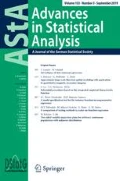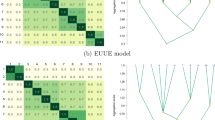Abstract
The classical Lorenz curve visualizes and measures the disparity of items which are characterized by a single variable: The more the curve bends, the more scatter the data. Recently a general approach has been proposed and investigated that measures the disparity of multidimensioned items regardless of their dimension.
This paper surveys various generalizations of Lorenz curve and Lorenz dominance for multidimensional data. Firstly, the Lorenz zonoid of multivariate data and, more general, of a random vector is introduced. Then three multivariate extensions of univariate Lorenz dominance are surveyed and contrasted, the set inclusion of lift zonoids, the scaled convex order, and the price Lorenz order. The latter is based on the set inclusion of extended Lorenz zonoids. Finally, a decomposition of the multivariate volume-Gini mean difference is given.
Similar content being viewed by others
References
Alker, H. (1965) Mathematics and Politics. MacMillan, New York
Atkinson, A. (1970) On the measurement of inequality. Journal of Economic Theory 2, 244–263
Atkinson, A., Bourguignon, F. (1982) The comparison of multidimensioned distributions of economic status. Review of Economic Studies 29, 183–201
Atkinson, A., Bourguignon, F. (1989) The design of direct taxation and family benefits. Journal of Public Economics 41, 3–29
Bhandari, S.K. (1988) Multivariate majorization and directional majorization: Positive results. Sankhya A 50, 199–204
Dyckerhoff, R. (2002) Inference based on data depth. Chapter 5 in (Mosler 2002).
Dyckerhoff, R., Koshevoy, G., Mosler, K. (1996) Zonoid data depth: Theory and computation. In: Prat, A. (ed.) COMPSTAT 1996, pp. 235–240. Physica-Verlag, Heidelberg
Goldie, C. (1977) Convergence theorems for empirical Lorenz curves and their inverses. Advances in Applied Probability Theory 9, 765–791
Hart, P. (1971) Entropy and other measures of concentration. Journal of the Royal Statistical Society, Series A 134, 73–89
Joe, H., Verducci, J. (1992) Multivariate majorization by positive combinations. In: Shaked, M., Tong, Y.L. (eds.) Stochastic Inequalities, pp. 159–181. IMS, Hayward
Kolm, S.C. (1969) The optimal production of social justice. In: Marjolis, J., Guitton, H. (eds.) Public Economics, pp. 145–200. Macmillan, New York
Kolm, S.C. (1977) Multidimensional egalitarianisms. Quarterly Journal of Economics 91, 1–13
Koshevoy, G. (1993) Multivariate inequality indices and orderings on a product of symmetric groups. Economica i Matematicheskie Methody 29, 245–256
Koshevoy, G. (1995) Multivariate Lorenz majorization. Social Choice and Welfare 12, 93–102
Koshevoy, G. (1998) The Lorenz zonotope and multivariate majorizations. Social Choice and Welfare 15, 1–14
Koshevoy, G. (2002) Orderings of Capacities. Lecture at the Bocconi University, Milano
Koshevoy, G. (2003) Lift zonoid and multivariate depths. In: Dutter, R., Filzmoser, P., Gather, U., Rousseeuw, P., Developments in Robust Statistics, pp. 193–201. Physica-Verlag, Heidelberg
Koshevoy, G., Mosler, K. (1996) The Lorenz zonoid of a multivariate distribution. Journal of the American Statistical Association 91, 873–882
Koshevoy, G., Mosler, K. (1997a) Zonoid trimming for multivariate distributions. The Annals of Statistics 25, 1998–2017
Koshevoy, G., Mosler, K. (1997b) Multivariate Gini indices. Journal of Multivariate Analysis 60, 252–276
Koshevoy, G., Mosler, K. (1998) Lift zonoids, random convex hulls and the variability of random vectors. Bernoulli 4, 377–399
Koshevoy, G., Mosler, K. (1999a) Price majorization and the inverse Lorenz function. Discussion Papers in Statistics and Econometrics 3, Universität zu Köln, 26 pp.
Koshevoy, G., Mosler, K. (1999b) Measuring multidimensional concentration: A geometrical approach. Allgemeines Statistisches Archiv 83, 173–188
Koshevoy, G., Möttönen, J., Oja, H. (2003) A scatter matrix estimate based on zonotope. The Annals of Statistics 31, 1439–1459
Koshevoy, G., Möttönen, J., Oja, H., Tyurin, Y. (2005) Dependency Tests Based on Zonotopes. Mimeo
Maasoumi, E. (1986) The measurement and decomposition of multidimensional inequality. Econometrica 54, 991–997
Lorenz, M.O. (1905) Methods of measuring the concentration of wealth. Publication of the American Statistical Association 9, 209–219
Mosler, K., Scarsini, M. (1993) Stochastic Orders and Applications. A Classified Bibliography. Springer, Berlin
Mosler, K. (1994a) Majorization in economic disparity measures. Linear Algebra and Its Applications 199, 91–114, Correction: 220, 3
Mosler, K. (1994b) Multidimensional welfarisms. In: Eichhorn, W. (ed.) Models and Measurement of Welfare and Inequality, pp. 808–820. Springer, Berlin
Mosler, K. (2001) Multidimensional indices and orders of diversity. Community Ecology 2, 137–143
Mosler, K. (2002) Multivariate Dispersion, Central Regions and Depth: The Lift Zonoid Approach. Springer, New York
Mosler, K. (2003) Central regions and dependency. Methodology and Computing in Applied Probability 5, 5–21
Mosler, K. (2004) Restricted Lorenz dominance of economic inequality in one and many dimensions. Journal of Economic Inequality 2, 89–103
Müller, A., Stoyan, D. (2002) Comparison Methods for Stochastic Models and Risk. Wiley, New York
Schneider, R. (1993) Convex Bodies: The Brunn-Minkowski Theory. Cambridge University Press, Cambridge
Sen, A.K. (1973) On Economic Inequality. Oxford University Press, Oxford
Shaked, M., Shanthikumar, J.G. (1994) Stochastic Orders and Their Applications. Academic Press, Boston
Tsui, K. (1995) Multidimensional generalizations of the relative and absolute inequality indices: The Atkinson-Kolm-Sen approach. Journal of Economic Theory 67, 251–265
Author information
Authors and Affiliations
Corresponding author
Rights and permissions
About this article
Cite this article
Koshevoy, G., Mosler, K. Multivariate Lorenz dominance based on zonoids . AStA 91, 57–76 (2007). https://doi.org/10.1007/s10182-006-0017-7
Received:
Revised:
Published:
Issue Date:
DOI: https://doi.org/10.1007/s10182-006-0017-7




